Modern telecommunication optical fibers
19. Apríl, 2010, Autor článku: Kádár Ondrej, Elektrotechnika
Ročník 3, číslo 4  Pridať príspevok
Pridať príspevok
 The paper deals with modern telecommunication optical fibers. The basic properties of optical fibers – dispersion and attenuation, their values and dependencies for modern telecommunication fibers are presented. The constructions of several telecommunication optical fibers types of requesting parameters are described. The measured results of attenuation and dispersion dependencies on macro–bend for three types of telecommunication optical fibers are presented and discussed.
The paper deals with modern telecommunication optical fibers. The basic properties of optical fibers – dispersion and attenuation, their values and dependencies for modern telecommunication fibers are presented. The constructions of several telecommunication optical fibers types of requesting parameters are described. The measured results of attenuation and dispersion dependencies on macro–bend for three types of telecommunication optical fibers are presented and discussed.
1. Introduction
Optical communication systems (OCS) use optical fibers for data transmission. Nowadays singlemode (SM) optical fibers are generally used in OCS. Multimode (MM) optical fibers are used partly in local area optical network.
Optical communication systems represent currently the most productive transfer systems. They used optical radiation with wavelength from 800 to 1650 nm (frequency few hundreds of THz) for high speed data transfer. The potential data bit rate of modern OCS is 10 Tbit/s and transmission capacity is Pb/s. Pretension to transfer velocity grow (40 and more Gbit/s), width the available spectrum grow – band S, E a U.
The modern types of telecommunication optical fibers were developed in harmony with these requests: NZ–DSF (Non Zero Dispersion Shifted Fiber) (with positive or negative dispersion slope) (ITU G.655), All – Wave – Zero OH – Absorption. Singlemode optical fibers can be divided by progress of dispersion characteristic on:
- Conventional fibers (CF) – with zero dispersion at 1310 nm
- Dispersion Shifted Fibers (DSF) – with zero dispersion in the area 1550 nm
- Dispersion Flattened Fibers (DFF) – with flat non zero dispersion in area from 1300 to1600 nm
Dispersion characteristic of these fibers are in the Fig.1. Refractive index profiles of various types of singlemode optical fibers are showed in Fig. 2.
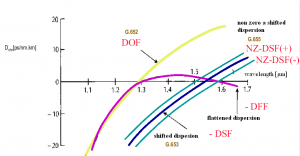
Fig.1. Progress of dispersion for standard optical fibers, DSF, DFF, NZDSF (N a P)
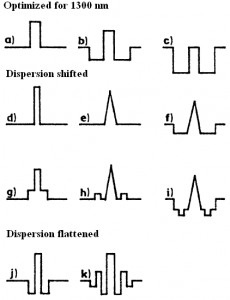
Fig.2. Refractive index profiles of various single–mode optical fibers
Singlemode optical fibers can be classified by attenuation as:
- Conventional fibers (CF), and
- All – Wave optical fibers, which have in area E smaller attenuation than conventional optical fibers (there is miss of attenuation at OH ions)
Progress of attenuation for standard optical fibers and All Wave optical fibers are showed at Fig.3.
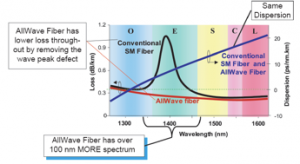
Fig. 3. Progress of attenuation for standard optical fibers and All Wave optical fibers
Modern telecommunication fibers are prepared by modification of dispersion characteristics (by modification of waveguide dispersion using different index profiles, see Fig.2).
2. Properties of singlemode optical fibers
The most important properties of optical fibers are dispersion and attenuation. Chromatic dispersion is manifest mostly, it is possible well compensate by contrast to polarization mode dispersion (PMD). PMD is manifest till from velocity 10Gbit/s.
2.1 Dispersion of optical fibers
Dispersion deforms transferred signal, it induces delay and expansion of impulses and changes their form. The overall SM fibers dispersion consists of chromatic and polarization mode dispersion.
2.1.1 Chromatic dispersion
It includes two kinds of dispersion:
- Material dispersion – is due to dependence of refractive index material of optical fibers from wavelength.
- Waveguide dispersion – is due to structure and geometric properties optical fibers.
The value of chromatic dispersion is characterized by coefficient of chromatic dispersion D (λ):
| (1) |
which specifies the change of group delay by fibers length in dependence on wavelength λ. The value of the coefficient specifies broadening of Gauss impulse in ps by use source of emission with spectral half – width 1nm (length of fiber is 1km). Spectral dependence of conventional singlemode fibers dispersion is showed at Fig.4.
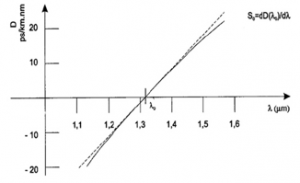
Fig.4. Spectral dependence of the chromatic dispersion coefficient D for conventional singlemode fibers, λ0 [nm] – wavelength of zero chromatic dispersion, S0 [ps/ (nm2×km)] – slope of dispersion characteristic in area of zero chromatic dispersion
The minimum of dispersion can be shifted to area 1550 nm (change zero point of chromatic dispersion) by:
- Minimizing of core diameter – change waveguide dispersion.
- Maximizing the relative value of refractive index Δ – change waveguide dispersion.
- Dope core for example with Ge – change material dispersion.
- Generation complicated refractive index profile in core – static, simpler and effective.
2.1.2. Polarization mode dispersion – PMD
Origin PMD consist in that optical fiber is not ideal circular and homogeneous. We talk, that in fiber is stay so called birefringence. The emission in the singlemode optical fiber is expansive in two together vertical plain – so –called polarization modes (general and next axis polarization). The emission is expansive in these two modes with different velocity. Because of at the end of route occur between both polarizations mode time delays. It occur extension of impulse, because impulse is totalled both modes. It limiting maximal transfer velocity of systems and it restriction signal – to – noise ratio (SNR). Time expansion of impulse reduces power peak of impulse (Fig.5.).
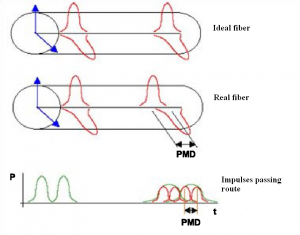
Fig. 5. Illustration of polarization mode dispersion
Delay change with change of wavelength and value of PMD is spectral middle value. PMD in long optical fiber does not grow linear, but it grows with root of distance. PMD grow linear for short optical fibers (to 10 km).
Short fibers:
| (2) |
Long fibers:
| (3) |
where Δτ – general delay L – length of optical fiber.
PMD is random quantity dependent at the time, wavelength, deformation fiber, band along routes. PMD is markedly weaker phenomenon than chromatic dispersion. PMD showed till from transfer velocity 10 Gbit/s. It is random phenomenon, which depend on installation routes and influence of environment. Compensation of PMD is too expensive, difficult and not fully effective. PMD is not possible exact calculate and is it needs measure in all stage life fiber – too after building routes. Urgency measuring extra applies to routes with old fibers.
2.2 Attenuation of optical fibers
Attenuation is one of the most important parameters of optical fiber. When optical fibers achieved attenuation less than 5 dB/km, than they were applied for telecommunication application.
Total attenuation of optical signal αT (dB):
| (4) |
where PT is input optical power and PR is output optical power of optical fiber. Attenuation of optical fibers on unit of length:
| (5) |
where L is length of optical fiber. Spectral dependence attenuation of optical fiber is shown in Fig. 6.
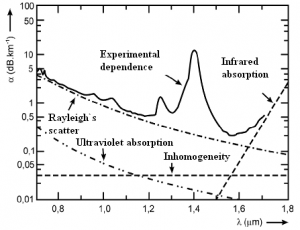
Fig. 6. Attenuation of optical fiber (SiO2)
Attenuation of optical fiber is caused by following several physical mechanisms.
- Material absorption loss is caused by the fiber itself or by impurities in the fiber. Intrinsic absorption has two components (ultraviolet and infrared absorption), it is due to interaction of transmitted light with SiO2. Extrinsic absorption is due to absorption on metal impurities (Cr, Cu, Fe, V, Ni, Mn) and on OH ions.
- Linear scattering loss – is due to linear transfer of optical power among modes. Rayleigh’s scattering is due to non–homogeneities in glass, of a size smaller than the wavelength. It is dominant scattering mechanism in silica fibers. Non–homogeneities are bigger than wavelength of optical signal by Mie`s scattering.
- Non – linear scattering loss is caused by high density of optical power in the optical fiber core. Non – linear scattering loss consists of the two following parts. Brillouin`s scattering is modulation of light on thermal vibration of molecules in optical fiber. When light encounters molecules in the air, the predominant mode of scattering is elastic scattering. It is also possible for the incident photons to interact with the molecules in such a way that energy is either gained or lost so that the scattered photons are shifted in frequency. Such inelastic scattering is called Raman`s scattering.
- Bending losses of optical fiber are generated as a result of breaking the conditions for the spread of light in bending field of optical fibers. Part of the electromagnetic field, which is on the outside of optical fibers, requires a greater spread in velocity as a part on the inner side. This includes losses due macro – bend and loss caused micro – bend. Losses incurred in bending bent into curves with a critical radius. Critical radius has a different relationship to singlemode and multimode fiber.
Relationship of critical radius for singlemode optical fiber:
| (6) |
Relationship of critical radius for multimode optical fiber:
| (7) |
where n1 is the refractive index of core and shell refractive index n2 of optical fibers, λc is the wavelength limit. Bending loss can be reduced by increasing the relative refractive index difference and core optical fiber shell, choosing the shortest working wavelength.
3. Experimental part
3.1. Measured samples of optical fiber
The following samples of optical fiber were measured. The first fiber was LEAF fiber with zero chromatic dispersion according to the standard International Telecommunication Authority ITU G.655. The second one sample was ATC fiber with parameters defined by ITU G.652. This fiber has zero chromatic dispersion at 1310nm wavelength band. The last sample is LEONI fiber with low sensitive on macro–bends loss with G.657 parameters.
The samples have the following physical parameters
- The first sample of fiber – SMF–type 28 LEAF 1099 with length 24 m (13 m fiber alone, 11 m interconnecting fibers) is from Corning according to ITU G.655.
- The second sample of fiber – standard singlemode optical fiber ATC 9 / 125 2000 with a length of 24 m (13 m fiber alone, 11 m interconnecting fibers) standard fiber according to ITU G.652.
- The third sample of fiber – fiber LEONI GIGALINE IV (ZN) H 1E9/125 STB 900H 2.0 10562972 LF 149641 with a length of 20 m (14 m fiber itself, 6 meter interconnecting fibers) according to ITU G.657.
3.2 Measuring devices
Attenuation was measured by direct method [6]. Agilent HP 8163 Lightwave multimeter was used for the measurement of attenuation. It has optical sources at 1310 nm and 1550 nm bands and also power meter. Universal test system EXFO FTB – 400 with analyzer polarization modes dispersion module FTB – 5500B [5] and broadband polarized optical source FLS – 110 were used for PMD measurement. Used measuring devices are shown in Fig .7 and Fig. 8.
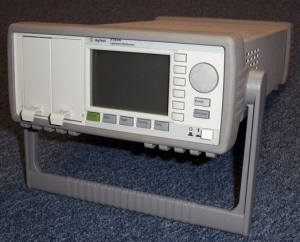
Fig.7. Multimeter Agilent HP 8163A [6]
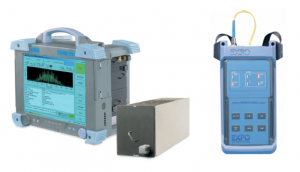
Fig.8. PMD Analyzer FTB – 5500B with universal test system FTB – 400, optical polarized source FLS – 11 [5]
3.3. Dependencies of attenuation from bend radius
Dependencies of attenuation on bend radius were measured on wavelength 1541.7 nm. Optical fibers were rolled step by step on rolls with radius 5 cm, 1.55 cm and 1.10 cm. Measured and calculated data are in Tables 1,2,3 and 4.
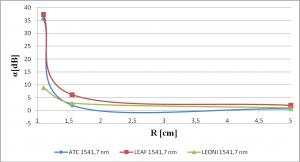
Fig.9. Dependence of attenuation on bend radius for wavelength 1541,7 nm
Fig. 9. shows dependence of attenuation on bend radius for optical fiber (standard optical fiber ATC, LEAF and the fiber less sensitive to bends LEONI). It was measured input and output optical power, which determines the attenuation of optical fiber.
| (8) |
Ratio of attenuation and length of optical fiber attenuation gives attenuation per length. The length of one turn is calculated simply by:
| (9) |
where R is the bend radius of optical fibers. I also calculated the attenuation for one turn.
| (10) |
| (11) |
L – is length of optical fiber, αdB – attenuation of optical fiber. Dependencies were measured at wavelength 1541.7 nm.
Table 1. Measured and calculated data for optical fiber ATC for bend radius
| Attenuation [dB] |
Bend radius [cm] |
Length of one turn [m] |
Attenuation for one turn [dB/turn] |
|---|---|---|---|
| 0,6479 | 5 | 0,314 | 0,0156493 |
| 2,0614 | 1,55 | 0,09734 | 0,0154351 |
| 35,6613 | 1,1 | 0,06908 | 0,1894987 |
Table 2. Measured and calculated data for optical fiber LEAF for bend radius
| Attenuation [dB] |
Bend radius [cm] |
Length of one turn [m] |
Attenuation for one turn [dB/turn] |
|---|---|---|---|
| 1,9379 | 5 | 0,314 | 0,0468077 |
| 6,0939 | 1,55 | 0,09734 | 0,0456292 |
| 37,2726 | 1,1 | 0,06908 | 0,1980609 |
Table 3. Measured and calculated data for optical fiber LEONI for bend radius
| Attenuation [dB] |
Bend radius [cm] |
Length of one turn [m] |
Attenuation for one turn [dB/turn] |
|---|---|---|---|
| 0,9551 | 5 | 0,314 | 0,0214215 |
| 2,8493 | 1,55 | 0,09734 | 0,0198108 |
| 8,9069 | 1,1 | 0,06908 | 0,0439492 |
3.4. Dependencies of PMD on bend radius
PMD of the fiber was measured with interferometric method at wavelength of 1550 nm (the wavelength is the source of FLS 110). Measured dependence of the PMD on bend radius is shown in Fig. 10. Measured data are in Table 4. By decreasing of bend radius the value of coefficient PMD is increasing. The greatest rate of increasing PMD occurs after bend radius below the critical radius. It is therefore important for the assembly and the handling of optical fibers that there is no bending with a radius smaller than the critical radius.
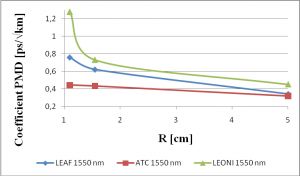
Fig.10. Dependence polarization mode dispersion on bend radius for different types of fibers
Table 4. Measured data of PMD for optical fibers ATC, LEAF and LEONI
| Sample | Delay PMD [ps] |
Coefficient PMD [ps/√km] |
Delay PMD of second order [ps/nm] |
Coefficient PMD of second order [ps/nm.km] |
Bend radius R [cm] |
|---|---|---|---|---|---|
| LEAF | 0,05 | 0,329 | 0,0012 | 0,0491 | |
| LEAF | 0,05 | 0,34 | 0,0013 | 0,0524 | 5 |
| LEAF | 0,1 | 0,62 | 0,0042 | 0,174 | 1,55 |
| LEAF | 0,12 | 0,759 | 0,0063 | 0,26 | 1,1 |
| ATC | 0,05 | 0,339 | 0,0011 | 0,0459 | 0 |
| ATC | 0,05 | 0,319 | 0,0012 | 0,052 | 5 |
| ATC | 0,07 | 0,432 | 0,0019 | 0,0772 | 1,55 |
| ATC | 0,08 | 0,443 | 0,002 | 0,0846 | 1,1 |
| LEONI | 0,05 | 0,441 | 0,0012 | 0,088 | |
| LEONI | 0,05 | 0,451 | 0,0013 | 0,0919 | 5 |
| LEONI | 0,09 | 0,73 | 0,0034 | 0,241 | 1,55 |
| LEONI | 0,15 | 1,277 | 0,0103 | 0,739 | 1,1 |
4. Conclusion
In the theoretical part of the work are briefly described the basic characteristics of modern telecommunications optical fiber, with a focus on the dispersion and attenuation. Mentioned are also the typical profiles of the refractive index for different types of fibers. In the experiments the dependence of the attenuation coefficient and PMD on bending radius for the standard telecommunications fiber ATC (ITU G.652), dispersion shifted LEAF fiber (DSF, ITU G.655), and less sensitive to bends LEONI fiber (ITU G.657) were measured. In this part the used measurement devices are described also.
From the measured results is visible that the measured value of attenuation for fiber LEONI is less than the value of attenuation for LEAF and ATC. Thus it is confirmed that the fiber LEONI is less sensitive to bending than the other two fibers. Generally the reducing the bending radius of the fiber causes the growing of the value of attenuation and PMD. The largest value of PMD was measured for fiber LEONI.
5. References
- Dubský, P., Kucharski, M.: Meranie prenosových parametru optických vláken kabelu a tras. Praha: Mikrokom, 1994.
- Dado, M., Turek, I., Štelina, J. a i.: Kapitoly z optiky pre technikov (kapitoly z optiky)
http://ukzu.utc.sk/htm/e-kn2auc.htm - Hajek, M., Holomeček, P.: Meraní chromatické a polarizační vidové disperze jedno vidových optických tras
http://www.mikrokom.eu/sk/pdf/CD-PMDcablex2002.pdf - Standards for optical fiber by International Telecommunication Union (ITU)
http://www.itu.int/rec/recquery_xml.asp?action=Search - Manuals to measuring devices FLS 110, FTB 400 and FTB 5500B from company EXFO
http://www.exfo.com/en/index.asp? - Manual for measuring device Agilent HP 8163A Lightwave Multimeter:
http://www.home.agilent.com/agilent/techSupport.jspx?pid=86130&pageMode=MN&cc=US&lc=eng - Specification of optical fiber LEAF from Corning
http://www.corning.com/docs/opticalfiber/pi1107.pdf - Specification of optical fiber LEONI:
http://pdf.directindustry.com/pdf/leoni-fiber-optics/fiber-optic-cables/14158-24338.html - Boháč, L.: Útlm
- Cvičenie 5 Vlastnosti optických vlákien
http://www.kemt.fei.tuke.sk/predmety/KEMT471_OE/_materialy/Ing_OE/Cvicenia/Cv05/OE_Cv5.pdf - Boháč, L.: Disperze optických vláken
- All – Wave Fiber
http://www.ofsoptics.com/resources/1693849504410786fa5a28AllWave-117-web.pdf
Coauthors of this paper are F. Uherek and J. Chovan; Slovak University of Technology, Faculty of Electrical Engineering and Information Technology, Ilkovičova 3, 812 19 Bratislava; International Laser Centre, Ilkovičova 3, 812 19 Bratislava.

